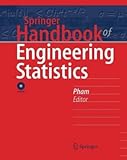Springer Handbook of Engineering Statistics
Engineers and practitioners contribute to society through their ability to apply basic scientific principles to real problems in an effective and efficient manner. They must collect data to test their products every day as part of the design and testing process and also after the product or process has been rolled out to monitor its effectiveness. Model building, data collection, data analysis and data interpretation form the core of sound engineering practice. After the data has been gathered the engineer must be able to sift them and interpret them correctly so that meaning can be exposed from a mass of undifferentiated numbers or facts. To do this he or she must be familiar with the fundamental concepts of correlation, uncertainty, variability and risk in the face of uncertainty. In today’s global and highly competitive environment, continuous improvement in the processes and products of any field of engineering is essential for survival. Many organisations have shown that the f
List Price: $ 199.00
Price: $ 95.79
Check This:
 A Slice of Six Sigma DVD: An easy-to-understand introduction for non-statisticians
A Slice of Six Sigma DVD: An easy-to-understand introduction for non-statisticiansA lot of people shy away from learning and using Six Sigma as part of their Continuous Improvement efforts because they think it r…
 The Certified Six Sigma Black Belt Handbook
The Certified Six Sigma Black Belt HandbookThe Certified Six Sigma Black Belt Handbook is the most comprehensive reference for all Six Sigma Black Belts (or anyone planning …
 The Six Sigma Black Belt Handbook, Chapter 1: Introduction to Six Sigma
The Six Sigma Black Belt Handbook, Chapter 1: Introduction to Six SigmaHere is a sample chapter from Six Sigma Black Belt Handbook, which offers the best and the latest information to assist you in s…



wide variety of topics,
This Handbook is useful as a concise summary of statistical methods that engineers are likely to need. The chapters are perhaps a little too terse, if you have never dealt with their topics before. But, assuming some prior background, then delving into a given chapter as a refresher can be quite handy.
There is a large variety of topics covered. Including for monitoring quality control in manufacturing processes. Or for predicting reliability of a complex package of software. Unsurprisingly, queuing theory gets a big mention. A longstanding topic for many engineers. Fancier stuff like genetic algorithms also get attention. It is unclear how many engineers actually use this material, however.
One might wonder at the text’s price. Out of reach of many students, though perhaps not for practising engineers.
Was this review helpful to you?

|